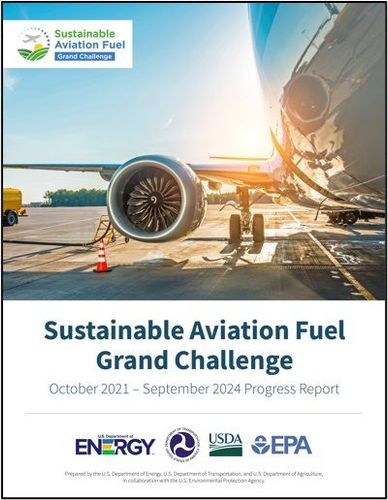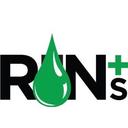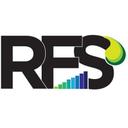Federal agencies publish SAF Grand Challenge progress report

SOURCE: U.S. Department of Energy
January 15, 2025
BY U.S. Department of Energy
As part of the Biden-Harris Administration's Investing in America agenda, an interagency team led by the U.S. Department of Energy (DOE), U.S. Department of Agriculture (USDA), and the U.S. Department of Transportation’s (DOT) Federal Aviation Administration (FAA) today released the Sustainable Aviation Fuel (SAF) Grand Challenge 2021-2024 Progress Report. The report underscores the Biden-Harris Administration's historic efforts to build a thriving bioeconomy that benefits all Americans, and addresses the goals set forth in the SAF Grand Challenge—a government-wide strategy for scaling up production of SAF that reduces cost, enhances sustainability, and expands the use of SAF across the U.S. airline industry.
“With the aviation sector growing each year, there is no better time to invest in solutions that are both technologically and commercially ready today,” said U.S Secretary of Energy Jennifer M. Granholm. “Sustainable aviation fuel will provide low carbon fuel made here in America to help decarbonize the hardest to reach areas in the transportation sector, and DOE is committed to supporting this effort which will lead to cleaner skies for all.”
“The Biden-Harris Administration has been the most supportive in our history of homegrown, renewable biofuels,” said Agriculture Secretary Tom Vilsack. “The SAF Grand Challenge has been a pivotal component of this effort, scaling up the production of low carbon aviation fuel, which in turn creates new revenue streams for farmers, taps into value-added climate-smart agriculture markets, and supports the clean energy transition in our transportation sector. USDA is proud to play a key role in turning the SAF Grand Challenge into a reality and help ensure the United States, and American agriculture, leads the global shift to cleaner, more sustainable energy.”
Advertisement
Advertisement
“The Biden-Harris Administration has taken action to reduce carbon pollution and ramp up the production of sustainable aviation fuel through our Investing in America agenda,” said U.S. Transportation Secretary Pete Buttigieg. “Over the past three years, as this Department has worked alongside our partners in the administration and in the private sector, we’ve made measurable progress in reducing emissions and making our skies cleaner while also growing the economy and creating good-paying jobs.”
The new 2021–2024 Progress Report is based on the Sustainable Aviation Fuel Grand Challenge Roadmap, which aims to scale up SAF production to reduce greenhouse gas (GHG) emissions by at least 50%; produce 3 billion gallons of SAF by 2030; and support 100% of domestic aviation fuel demand by 2050. The Progress Report also defines metrics and baselines progress toward these goals. Federal agencies have made strides in expanding U.S. SAF production by releasing new funding opportunities and initiatives; providing expertise and technical assistance to industry; increasing interagency collaboration; and providing data, modeling, and analysis to decision makers.
Since the launch of the SAF Grand Challenge in 2021, the new 2021–2024 Progress Report shows that the SAF Interagency Working Group has:
Advertisement
Advertisement
- Published the SAF Grand Challenge Roadmap in 2022, and the SAF Grand Challenge Roadmap Implementation Framework in 2024.
- Developed and released the SAF Grand Challenge: Tracking Metrics and Mid-2024 Dashboard in 2024, to be updated annually. Newly updated metrics in this Progress Report show that 30 million gallons of SAF have been produced domestically in the first three quarters of 2024, up from 5 million gallons in 2021. Currently announced domestic projects represent over 3 billion gallons of annual SAF production capacity — representing $44 billion of announced investment — by 2030. If 100% of announced capacity comes online as planned, production capacity will exceed the domestic 3 billion gallon per year by the 2030 target.
- Coordinated agency information exchange and stakeholder engagement to understand industry developments, including hosting SAF stakeholder events and financial workshops with agricultural producers, industry, and researchers.
- Performed collaborative interagency research, development, demonstration, and deployment (RDD&D) aligned with the roadmap action areas.
Federal agencies continue to collaborate with private-public partners including national laboratories, universities, nongovernmental organizations, and the aviation, agriculture, and energy industries to scale up production of SAF. From feedstock innovation and conversion technologies to building supply chains, policy, and valuation analysis, and enabling end use, Federal agencies are accelerating innovation on the path to a decarbonized aviation sector. For example, DOE funding helped develop and test a new method for producing SAF using ethanol, called “alcohol-to-jet.” This investment paid off—the technology has been commercialized, and the company LanzaJet has, with further DOE funding, recently opened the world’s first ethanol to SAF production facility in Soperton, Georgia. The facility can produce 10 million gallons of SAF a year and will help boost the rapidly growing domestic SAF industry.
SAF production is critical for the aviation industry. It creates new economic opportunities in agricultural and rural communities while reducing environmental impacts. It also supports U.S. energy independence and global competitiveness. The U.S. transportation sector has become the largest source of carbon dioxide (CO2) emissions in the country with aviation generating approximately 11% of U.S. transportation-based CO2 emissions that contribute to climate change. As the global aviation industry looks to reduce emissions, the United States stands at a competitive advantage to grow this new industry. Key accomplishments also highlighted in the Progress Report from DOE, DOT, and USDA since the SAF Grand Challenge was announced in 2021 include:
- DOE’s Bioenergy Technologies Office has awarded $151 million in funding for 28 pre-pilot, pilot, and demonstration-scale projects. This includes one SAF commercial deployment project. This funding is leveraging an estimated $156 million in private sector funding.
- USDA provided $18 million in funding from the Agriculture and Food Research Initiative Sustainable Agricultural Systems program for the development of three integrated supply chain projects, as well as $30 million for a SAF commercial deployment project. This funding is leveraging an estimated $175 million in private sector funding.
- The FAA has invested $5 million in the ASTM fuels clearinghouse. Two new pathways have been approved, and eight are currently at various stages of the approval process. This is leveraging an estimated $100 million in private sector funding.
- The FAA announced awards of $249 million to advance the deployment of SAF through the Fueling Aviation's Sustainable Transition (FAST) program. This funding was made possible by the Inflation Reduction Act of 2022 and is expected to leverage at least $83 million in private sector funding.
Learn more about key accomplishments from federal agencies as categorized by action areas in the Sustainable Aviation Fuel (SAF) Grand Challenge 2021-2023 Progress Report.
Related Stories
MOL Group has produced a diesel fuel containing hydrotreated vegetable oil (HVO), and sustainable aviation fuel (SAF) at the refinery of Slovnaft in Bratislava. The quality of the products has been verified by radioisotope analysis.
More than 1.76 billion renewable identification numbers (RINs) were generated under the Renewable Fuel Standard in January, down from 1.91 billion generated during the same period of 2024, according to data released by the U.S. EPA on Feb. 20.
The U.S. EPA on Feb. 20 released updated small refinery exemption (SRE) data showing that 13 previously denied SRE petitions for Renewable Fuel Standard compliance years 2021 and 2022 are being reconsidered. No new SRE petitions were filed.
A coalition of biofuel, agriculture, fuel retailer and petroleum trade groups on Feb. 19 sent a letter to U.S. EPA Administrator Lee Zeldin urging the agency to set robust, timely, multiyear RFS RVOs for 2026 and beyond.
OMV Petrom has announced the start of construction for a sustainable aviation fuel (SAF) and renewable diesel (HVO) production unit at the Petrobrazi refinery in Romania. The new facility will have an annual capacity of 250,000 tons.
Upcoming Events










